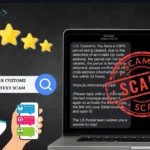Scammers are targeting more people as digital services become part of daily life. One common scam is the “CA Toll Invoice” scam, where people get text messages claiming they owe money for unpaid tolls.
These texts pressure for fast payment and threaten extra fees if ignored. This article will explain how the scam works, warning signs to watch for, and steps to take if you become a victim.
Ca Toll Invoice Text Scam Overview
The CA Toll Invoice scam targets California drivers through fake text messages claiming they have unpaid toll fees.
The scam creates urgency by threatening extra charges or legal action if they don’t pay right away.
The texts direct victims to fake websites that ask for personal information, like credit card details.
How Does Ca Toll Invoice Text Scam Work?
Scammers behind the CA Toll Invoice text use different tactics to trick people into paying fake fees.
It starts with a text message that seems to come from a real toll service, which claims you owe unpaid toll fees. The message uses official-sounding names like “CA Toll Services” or “Dud Seattle Invoice Co” to make it seem legit.
They push for quick payment by saying more fees will be added if you don’t act fast, and they often use small amounts like “$0.79” to make it seem believable. They even threaten legal action to add more pressure.

The message includes a link to a fake website that looks like a toll collection page. On the site, you’re asked to enter personal details like your name, address, and credit card information.
Once you provide your information, the scammers claim your “invoice” is paid, which makes you feel relieved. However, they now have your personal and financial details, which they can use for identity theft or unauthorized transactions.
What To Do If You Receive This Scam Message
If you receive these suspicious texts, follow these steps to stay away from these types of scams.
- Share information about this scam with your friends and family. Scammers count on people not knowing, so spreading the word can help keep others safe.
- Stay away from any links in the message. They take you to fake websites that try to steal your information.
- If you’re not sure whether you owe toll fees, contact the official toll service provider directly. Visit their verified website or call their customer service. For example, you can check your account with FasTrak online.
- Let your cell phone provider, the Federal Trade Commission (FTC), or the California Attorney General’s office know about the scam. Reporting it helps authorities track down the scam and shut down fake websites.
- Once you confirm it’s a scam, block the sender’s number so you don’t get more messages from them.

Erika is a Computer Science student with a passion for reading and digital exploration. She loves to read personal growth books and spends her free time navigating various websites, improving her technological skills and understanding of web platforms. Erika is particularly interested in cybersecurity and stays updated on news related to scams and fraud. Her curiosity and dedication push her to pursue a career where she can innovate and improve digital safety and user experiences.







